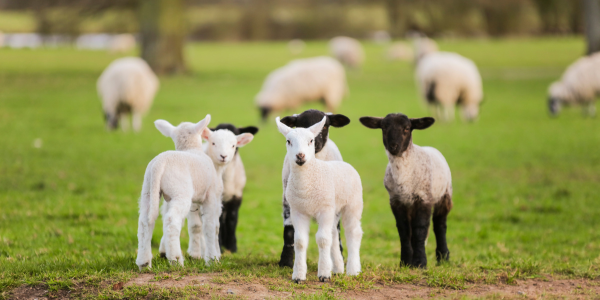The traditional approach of using milk powders as a last resort for orphaned lambs is evolving. Nowadays, many sheep producers recognise the substantial productivity gains achievable through the regular use of milk replacers as part of their management strategy. This shift is transforming lamb rearing practices, driving better health outcomes, and improving overall flock productivity.
The Importance of Modern Lamb Rearing
Higher lambing percentages put pressure on lamb survivability and ewe productivity. This necessitates a renewed focus on meticulous management to maximise lamb health and minimise any adverse effects on the ewe. Ensuring we are doing the best for our animals is paramount.
Modern manual rearing systems offer the potential to accelerate lamb growth rates, either targeting earlier market opportunities or integrating genetically desirable lambs back into the flock at a suitable joining weight at a younger age. Crucially, these systems also benefit the ewe by managing her nutrition correctly, thus minimising any negative impact on her reproductive performance and overall productivity.
However, these intensive rearing systems can be challenging if not executed properly. To ensure success, it is essential to focus on three key areas: Hygiene, Nutrition, and Comfort.
Hygiene: The Foundation of Lamb Health
Maintaining impeccable hygiene is crucial to prevent disease and promote healthy growth. This begins with the lambing area and extends to the environment where the lambs will live.
- Lambing Area and Living Environment: Ensure that the area is clean, dry, and well-ventilated, but free from drafts. Implement an induction process for all lambs, including weighing, tagging, and health checks/treatments as recommended by your vet.
- Segregation and Quarantine: Facilities should allow for the segregation of different batches of lambs to prevent the spread of disease. Quarantine areas are essential for isolating any sick animals, minimising the risk of infection to healthy lambs.
- Feeding Equipment and Staff Hygiene: Maintain rigorous hygiene standards for feeding equipment and ensure that all staff involved in feeding follow clear, standardised processes. This reduces the risks of contamination and disease transmission.
Nutrition: The Cornerstone of Growth and Development
Providing optimal nutrition is vital for the growth and health of lambs. Start with high-quality colostrum, which should be delivered promptly after birth (15% of body weight within the first 24 hours).
- Milk Replacers: Use high-quality milk replacers, ensuring consistent concentrations and feed volumes at regular intervals. Aim to provide 10-15% of a lamb’s body weight in milk per day. Consistency in feeding times and amounts is key to promoting steady growth.
- Solid Feeds and Water: Always provide lambs with access to fresh, clean water and quality solid feeds. When planning to wean lambs from milk, monitor their meal consumption—aim for a minimum of 200 grams of meal per day for three consecutive days—and ensure they reach target body weights.
Comfort: Creating the Ideal Environment
A warm, clean, and dry environment is essential for lambs’ comfort and well-being. Proper ventilation is necessary to prevent respiratory issues, but the area should be free from drafts.
- Pen Size and Group Management: Use a guideline of 0.5 square meters of space per lamb. Consider what group sizes are manageable for you and your staff, especially regarding feeding and observation.
- Bedding and Shelter: Provide adequate bedding to keep lambs dry and comfortable. Ensure shelters protect from extreme weather conditions while maintaining good air circulation.
Incorporating modern rearing techniques and focusing on hygiene, nutrition, and comfort can significantly improve lamb health and productivity. By embracing these practices, sheep producers can ensure that they are providing the best care for their animals, leading to healthier lambs, more productive ewes, and ultimately, better commercial outcomes. The future of lamb rearing lies in these proactive, well-managed systems that prioritise the well-being of both lambs and ewes.
Ready to boost your lamb rearing success?
Contact us now to learn how our high-quality milk replacers and rearing systems can transform your operations. Achieve healthier lambs, more productive ewes, and greater profitability today!

